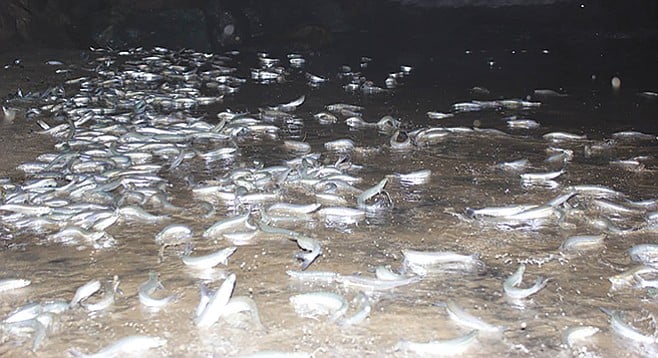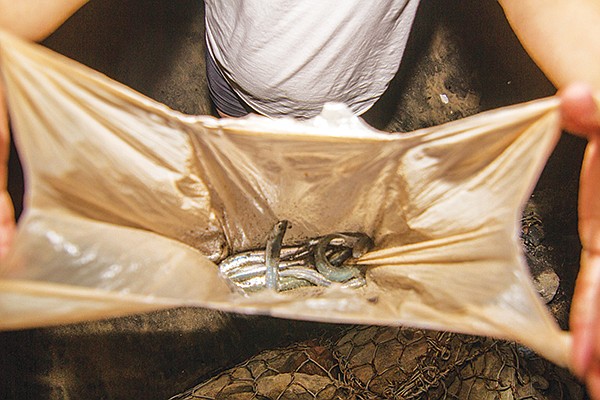 Facebook
Facebook
 X
X
 Instagram
Instagram
 TikTok
TikTok
 Youtube
Youtube

It’s 11:40 p.m. on a Thursday night in Ocean Beach. I’m wolfing down a burrito from Roberto’s while padding across Dog Beach to the river. Salsa and greasy frijoles ooze between my fingers into the crevices of a digital sound recorder. I curse at my attempt to juggle dinner and devices, but I’m in a rush. The grunion are running.

It was only a few years ago when I added the ritual observation of this seasonal phenomenon to my panoply of pagan rituals. I had just established California residency as a maverick OBcean on Saratoga-at-Abbott. A fish biologist by training, I was thrilled to be able to visit the sea so easily and network with all the new-to-me West Coast species. My guide was Certainly More Than You Want To Know About the Fishes of the Pacific Coast, a brick of a book by UCSB professor emeritus Milton Love. (Challenge accepted, by the way.)

From this mighty tome I learned that the grunion had one of the easiest schedules to intercept: February to September, up to four days after the full or new moon, up to two hours after high tide at night, along a California beach. Being late March at the time, I checked the tides, walked to the seashore, and, lo, delivered upon the first wave were hundreds of scaly silver bodies, flopping around in ecstatic orgy.

They come ashore during the aforementioned window to bury their eggs as high up the beach as they could, thereby protecting them from ocean predators during incubation. To find the fish so easily had me giggling, grinning, and frolicking like a madman; thankfully not an odd sight on Ocean Beach.

Here in Southern California, grunion-running time is always after 10 p.m. (Yes, tide times advance daily, but similar moon phases have similar tides.) Despite the late hour, I always see a few similarly goofy humans dodging waves and waving flashlights. Many of them carry buckets and snatch up the fish willy-nilly. But at eight inches long, they seemed too paltry to eat. Indeed, my guidebook made no mention of grunion consumption. So...? (Your move, Dr. Love.) Of course I was raised on the fillet, that aesthetically pleasing but wasteful American preparation style. Conversely, San Diegans are a diverse bunch. Our locals mingle with a constant stream of immigrants from landlocked states and foreign lands alike. Surely there was a story among my fellow grunioneers, and perhaps a recipe to boot.
Flash forward to the aforementioned burrito ooze. It has been three days since the new moon of March 28th. I’ve learned by now that runs are stronger in the latter days and hours of their schedule, so I’m hoping for a good turnout tonight. I’ve committed myself to walk back and forth along the beach until the run subsides around 1:40 a.m., interviewing all grunioneers along the way. I trudge toward the first light and meet “Fisherman Dan.”
He’s got himself a good spot, next to a jetty where the fish seem to be concentrated. He’s using a red light and chasing after the fishes before they can rocket through the sandy backwash into the sea again. “Your light actually scares ’em,” he says. Indeed, fewer fish seem to flop in when the waves are lit. I ask him what he does with the fish, and he indicated his bucket full of seawater. Ah, of course, free bait. Dan is not a grunion consumer. I move on.
“Woof!” Whoosh. I meet my spirit animal. Archie the white husky zooms by, enjoying this piscine bonanza on his first birthday. His people are nearby. Jimmy and Bill are locals and neighbors in Point Loma. Katie and Peter are visiting them from out of state. I asked about their relationship to the little fish and discover that they are also first-timers. Did they plan on eating any? “I just want to watch ’em. Happy to let them do their thing,” Jimmy says.
“He also likes watching orgies,” Bill added.
Ah, male camaraderie.
Dave and Jason are next, a local father-son grunion-grabbing team. Dave grunts shy one-word answers to my questions. He has the light smile, easy gait, and facial scruff of a man you’d try to set up with your divorced mother. I was about to leave him in peace when his son showed up via Uber. He had a light buzz on after his closing shift at an Old Town restaurant. Unlike his father, Jason gabbed with me about all sorts of fishing strategies. “The predator fish come in behind the grunion,” he said, listing off how many fish would be biting during the runs — including “skates...out the [expletive]!” The two were stuffing their catch into plastic bags (now endangered in California) for freezing. There are no limits on grunion in season (June 1st to March 31st), which allows them to pack away a large quantity of free bait. I ask my question about their relationship to the grunion, even though it’s pretty clear they don’t eat them.
“The memories we’ve made using them for bait... Like, [we’ve caught] the biggest calico bass I’ve ever seen in my life [using grunion] in places that honestly [the bass] shouldn’t be able to get in at all.”
I’m sure Dave is proud.
The rest of the evening brings more of the same. I speak with all 27 people I find fishing the grunion that Thursday night along the half-mile stretch of Ocean Beach. I’m surprised to discover that two thirds of them are on their first grunion run. Only six could be considered veteran grunioneers, having fished for more than one season. Most are small groups with a ringleader that had convinced their first-timer friends to come along despite having only just heard of the fish. One guy I speak with is actually quite spooked by it all, believing the fish are beaching themselves because the world is coming to an end. Another man with lucky timing has just arrived from Oklahoma with his two young daughters for their first visit to the ocean.
Perhaps most interesting to me is that not one white person I speak with is planning on eating the buggers. It was our immigrants — nearly half of that night’s grunioneers — who rescued me with recipes.
Tunk, Aom, Soon, and Fon are four young Thai graduate students that have been studying in San Diego for the past four years. Their ringleader tells me she’d caught grunion a few times before. A few years, did she mean? “Noooo, yesterday!” she replied. We all laugh.
I ask what they would do with them. Tunk, the lone and lanky male in their party, said, “Oh, you know, make like a deep-fry, maybe with a spicy sauce.” I beg them for cooking instructions. Do they plan on gutting them? Or perhaps chopping off their heads? Tunk assures me they ate them whole. Weren’t they concerned about the bones? “You just need more time for frying, then the bones become crispy! Maybe ten minutes.”
It seems so simple and easy. We exchanged numbers to follow up about the results. A few days later I receive a photo of fried grunion with the caption, “They were better than I thought!”
Nine other grunioneers on the beach have experience eating them, including four Latinos from Chula Vista and one Asian guy named Bao. But only one more group is here to catch them for food. These four young professional Filipino-Americans, de facto natives by accent and culture since they moved as young children, are catching the fish for their parents. Joseph is their ringleader and “an avid fisherman,” according to his sister Jane, who is attending for her first time. Only Joseph knows how to cook them — and it differs from Tunk’s method.
“Gut them, soak them in vinegar, let them dry for a day or two, and then fry it so it’s nice and crispy.”
We chat for a while longer about grunion biology, and I show them where and how the eggs are being laid in the sand. I wish them well before slinking back to my apartment in my squishy Adidas sneakers. The two-hour window is up, and the grunion have returned to the sea.
(The next grunion run is July 9-12.)


It’s 11:40 p.m. on a Thursday night in Ocean Beach. I’m wolfing down a burrito from Roberto’s while padding across Dog Beach to the river. Salsa and greasy frijoles ooze between my fingers into the crevices of a digital sound recorder. I curse at my attempt to juggle dinner and devices, but I’m in a rush. The grunion are running.

It was only a few years ago when I added the ritual observation of this seasonal phenomenon to my panoply of pagan rituals. I had just established California residency as a maverick OBcean on Saratoga-at-Abbott. A fish biologist by training, I was thrilled to be able to visit the sea so easily and network with all the new-to-me West Coast species. My guide was Certainly More Than You Want To Know About the Fishes of the Pacific Coast, a brick of a book by UCSB professor emeritus Milton Love. (Challenge accepted, by the way.)

From this mighty tome I learned that the grunion had one of the easiest schedules to intercept: February to September, up to four days after the full or new moon, up to two hours after high tide at night, along a California beach. Being late March at the time, I checked the tides, walked to the seashore, and, lo, delivered upon the first wave were hundreds of scaly silver bodies, flopping around in ecstatic orgy.

They come ashore during the aforementioned window to bury their eggs as high up the beach as they could, thereby protecting them from ocean predators during incubation. To find the fish so easily had me giggling, grinning, and frolicking like a madman; thankfully not an odd sight on Ocean Beach.

Here in Southern California, grunion-running time is always after 10 p.m. (Yes, tide times advance daily, but similar moon phases have similar tides.) Despite the late hour, I always see a few similarly goofy humans dodging waves and waving flashlights. Many of them carry buckets and snatch up the fish willy-nilly. But at eight inches long, they seemed too paltry to eat. Indeed, my guidebook made no mention of grunion consumption. So...? (Your move, Dr. Love.) Of course I was raised on the fillet, that aesthetically pleasing but wasteful American preparation style. Conversely, San Diegans are a diverse bunch. Our locals mingle with a constant stream of immigrants from landlocked states and foreign lands alike. Surely there was a story among my fellow grunioneers, and perhaps a recipe to boot.
Flash forward to the aforementioned burrito ooze. It has been three days since the new moon of March 28th. I’ve learned by now that runs are stronger in the latter days and hours of their schedule, so I’m hoping for a good turnout tonight. I’ve committed myself to walk back and forth along the beach until the run subsides around 1:40 a.m., interviewing all grunioneers along the way. I trudge toward the first light and meet “Fisherman Dan.”
He’s got himself a good spot, next to a jetty where the fish seem to be concentrated. He’s using a red light and chasing after the fishes before they can rocket through the sandy backwash into the sea again. “Your light actually scares ’em,” he says. Indeed, fewer fish seem to flop in when the waves are lit. I ask him what he does with the fish, and he indicated his bucket full of seawater. Ah, of course, free bait. Dan is not a grunion consumer. I move on.
“Woof!” Whoosh. I meet my spirit animal. Archie the white husky zooms by, enjoying this piscine bonanza on his first birthday. His people are nearby. Jimmy and Bill are locals and neighbors in Point Loma. Katie and Peter are visiting them from out of state. I asked about their relationship to the little fish and discover that they are also first-timers. Did they plan on eating any? “I just want to watch ’em. Happy to let them do their thing,” Jimmy says.
“He also likes watching orgies,” Bill added.
Ah, male camaraderie.
Dave and Jason are next, a local father-son grunion-grabbing team. Dave grunts shy one-word answers to my questions. He has the light smile, easy gait, and facial scruff of a man you’d try to set up with your divorced mother. I was about to leave him in peace when his son showed up via Uber. He had a light buzz on after his closing shift at an Old Town restaurant. Unlike his father, Jason gabbed with me about all sorts of fishing strategies. “The predator fish come in behind the grunion,” he said, listing off how many fish would be biting during the runs — including “skates...out the [expletive]!” The two were stuffing their catch into plastic bags (now endangered in California) for freezing. There are no limits on grunion in season (June 1st to March 31st), which allows them to pack away a large quantity of free bait. I ask my question about their relationship to the grunion, even though it’s pretty clear they don’t eat them.
“The memories we’ve made using them for bait... Like, [we’ve caught] the biggest calico bass I’ve ever seen in my life [using grunion] in places that honestly [the bass] shouldn’t be able to get in at all.”
I’m sure Dave is proud.
The rest of the evening brings more of the same. I speak with all 27 people I find fishing the grunion that Thursday night along the half-mile stretch of Ocean Beach. I’m surprised to discover that two thirds of them are on their first grunion run. Only six could be considered veteran grunioneers, having fished for more than one season. Most are small groups with a ringleader that had convinced their first-timer friends to come along despite having only just heard of the fish. One guy I speak with is actually quite spooked by it all, believing the fish are beaching themselves because the world is coming to an end. Another man with lucky timing has just arrived from Oklahoma with his two young daughters for their first visit to the ocean.
Perhaps most interesting to me is that not one white person I speak with is planning on eating the buggers. It was our immigrants — nearly half of that night’s grunioneers — who rescued me with recipes.
Tunk, Aom, Soon, and Fon are four young Thai graduate students that have been studying in San Diego for the past four years. Their ringleader tells me she’d caught grunion a few times before. A few years, did she mean? “Noooo, yesterday!” she replied. We all laugh.
I ask what they would do with them. Tunk, the lone and lanky male in their party, said, “Oh, you know, make like a deep-fry, maybe with a spicy sauce.” I beg them for cooking instructions. Do they plan on gutting them? Or perhaps chopping off their heads? Tunk assures me they ate them whole. Weren’t they concerned about the bones? “You just need more time for frying, then the bones become crispy! Maybe ten minutes.”
It seems so simple and easy. We exchanged numbers to follow up about the results. A few days later I receive a photo of fried grunion with the caption, “They were better than I thought!”
Nine other grunioneers on the beach have experience eating them, including four Latinos from Chula Vista and one Asian guy named Bao. But only one more group is here to catch them for food. These four young professional Filipino-Americans, de facto natives by accent and culture since they moved as young children, are catching the fish for their parents. Joseph is their ringleader and “an avid fisherman,” according to his sister Jane, who is attending for her first time. Only Joseph knows how to cook them — and it differs from Tunk’s method.
“Gut them, soak them in vinegar, let them dry for a day or two, and then fry it so it’s nice and crispy.”
We chat for a while longer about grunion biology, and I show them where and how the eggs are being laid in the sand. I wish them well before slinking back to my apartment in my squishy Adidas sneakers. The two-hour window is up, and the grunion have returned to the sea.
(The next grunion run is July 9-12.)
Comments